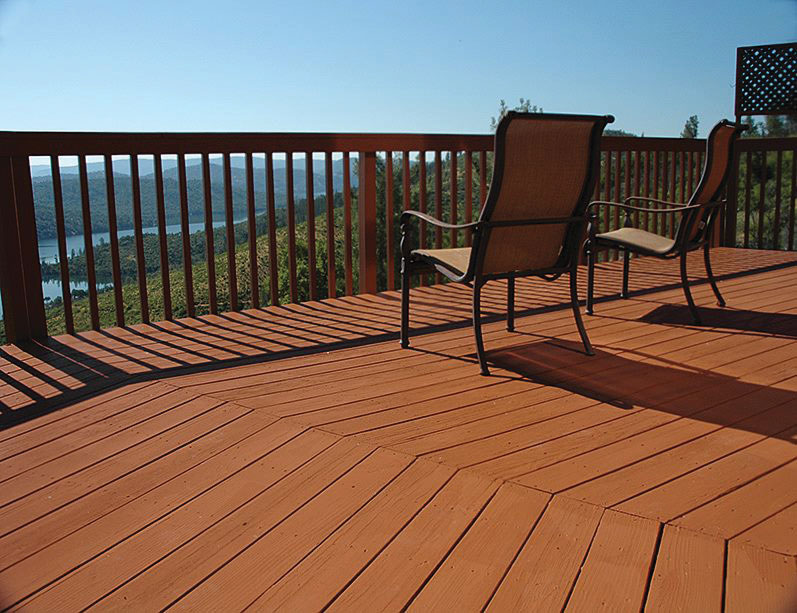Chicago Deck Staining Services: Expert Results Ensured
Chicago Deck Staining Services: Expert Results Ensured
Blog Article
A Comprehensive Overview to Different Types of Deck Staining Techniques for Ultimate Protection and Appearances
In the world of deck maintenance, the art of staining stands as a crucial step towards both maintaining the stability of your outdoor room and improving its visual charm. As we navigate via the complex world of deck discoloration techniques, one starts to value the nuanced techniques that can make all the difference in between an average finish and a perfect one.
Understanding Various Sorts Of Spots
Various types of discolorations are frequently utilized in the process of deck discoloration to accomplish various aesthetic and safety impacts. Clear stains are optimal for showcasing the all-natural grain of the wood while supplying marginal protection versus UV rays and moisture. On the other hand, semi-transparent stains use an equilibrium between color improvement and protection, enabling some timber grain to show with. For an extra opaque coating that provides maximum security versus the elements, strong stains are the favored selection. These stains are available in a wide range of colors and effectively conceal the timber grain.
Moreover, there are additionally specialized stains such as toners and sealers. Toners include a tip of shade to the timber while giving marginal defense, making them suitable for newer decks with less wear. Sealers, on the other hand, offer protection against moisture and UV rays without adding shade, making them a prominent option for decks that currently boast a preferable shade. Recognizing the characteristics and benefits of each type of stain is important for accomplishing the preferred look and longevity for your deck.
Selecting the Right Discoloration Shade
When taking into consideration the aesthetics of your deck discoloration job, the option of stain color plays a critical function in enhancing the safety top qualities of the selected tarnish kind (Right Deck Stain). The shade you select can considerably influence the general look of your deck, along with its capability to endure the components gradually
When selecting a tarnish color, it's necessary to take into consideration the existing color design of your home's outside. Harmonizing the deck tarnish with the overall visual of your residential property can create a natural and visually enticing outside space. In addition, the color of your deck discolor can affect the temperature of the deck surface area; darker colors have a tendency to soak up more warmth, while lighter colors show sunshine and stay cooler.
Additionally, the sort of wood you are discoloring will certainly also impact just how the stain shade shows up. Different timber varieties can communicate with the discolor in numerous ways, possibly modifying the final color. It's suggested to test the discolor on a little, low-profile area of the deck to ensure the color ends up as desired before waging the entire project.
Preparing Your Deck for Discoloration
To guarantee a successful and lasting deck staining task, comprehensive prep work of the deck surface is necessary. Begin by cleaning up the deck completely to get rid of dust, gunk, mold, and any type of old complete or stain.
Evaluate the deck for any type of harmed or rotten boards that require to be replaced. Hammer down any sticking out nails and sand any kind of harsh locations to make sure a smooth surface for staining. Look for any kind of loose railings or steps that may require tightening up or repair work.
When the deck is clean, completely dry, and in great repair, think about applying a timber brightener to restore the deck's all-natural shade and open up the timber pores for much better tarnish penetration. Safeguard any kind of nearby plants, furnishings, or surfaces with plastic sheet prior to proceeding with the discoloration process. Correct preparation is essential to attaining a professional-looking finish and maximizing the longevity look what i found of your deck discolor.
Using Stain With Different Strategies
For a flawless and expert coating, the method of applying discolor plays an essential function in boosting the look and sturdiness of your deck. There are numerous techniques you can utilize to make sure a reliable application of stain.
Brushing is a conventional method that enables accuracy and control over the quantity of tarnish used. It is ideal for elaborate areas and getting to in between deck boards (Stain Deck). Rolling is a Web Site quicker option, covering larger surface effectively. Nevertheless, back-brushing after rolling is suggested to also out the tarnish and function it right into the timber for far better infiltration.
Splashing is one more popular strategy, supplying speed and ease of application, specifically for big deck locations. Whichever method you choose, making certain proper prep work and complying with manufacturer standards will certainly aid achieve a lovely and lasting discolor finish on your deck.

Preserving and Re-staining Your Deck
Appropriate upkeep and timely re-staining are necessary for protecting the beauty and durability of your deck. Routine upkeep jobs consist of brushing up off debris, cleaning up with a deck cleaner, and checking for any indicators of wear or damages. Resolving issues without delay can stop extra substantial issues in the future. When it involves re-staining your deck, the frequency relies on different variables such as the kind of tarnish made use of, the climate in your location, and just how much wear and tear your deck experiences. Generally, it is suggested to re-stain your deck every 2-4 years to maintain its defense and aesthetics.
Before re-staining, guarantee the deck is tidy, dry, and cost-free of any previous tarnish residue. Select a premium discolor that suits your deck's material and provides the wanted degree of defense.
Final Thought
In conclusion, understanding the various sorts of deck spots, selecting the ideal shade, appropriately preparing the deck, applying tarnish with different strategies, and re-staining the deck and preserving are necessary actions for best protection and visual appeals. By adhering to these steps, you can make certain that your deck remains in leading problem for years ahead.
In addition, the shade of your deck tarnish can influence the temperature of the deck surface area; darker colors have a tendency to soak up even more warmth, while lighter shades mirror sunshine and remain cooler.
It's recommended to check the discolor on a tiny, inconspicuous this link area of the deck to guarantee the shade turns out as wanted before continuing with the whole job.

Report this page